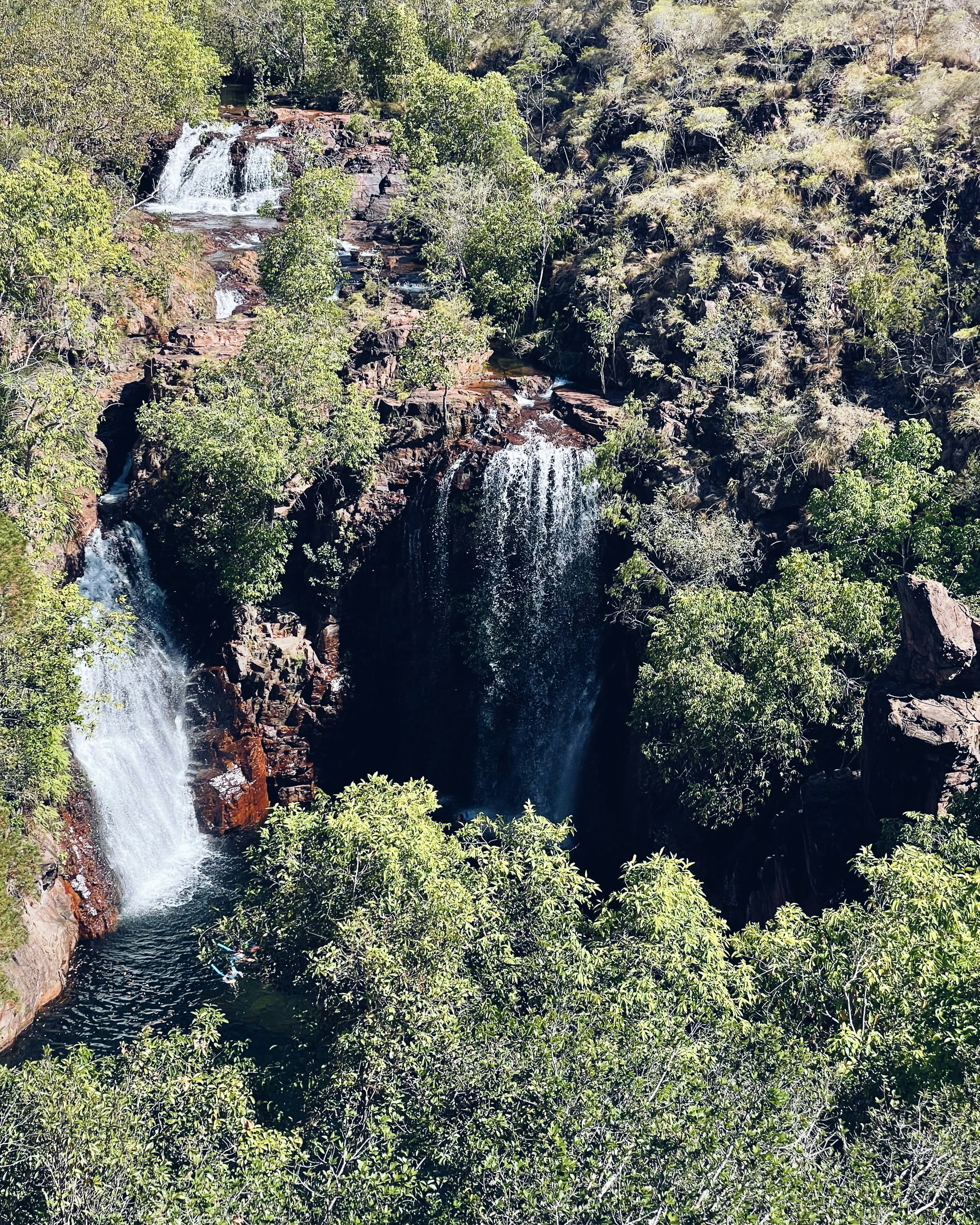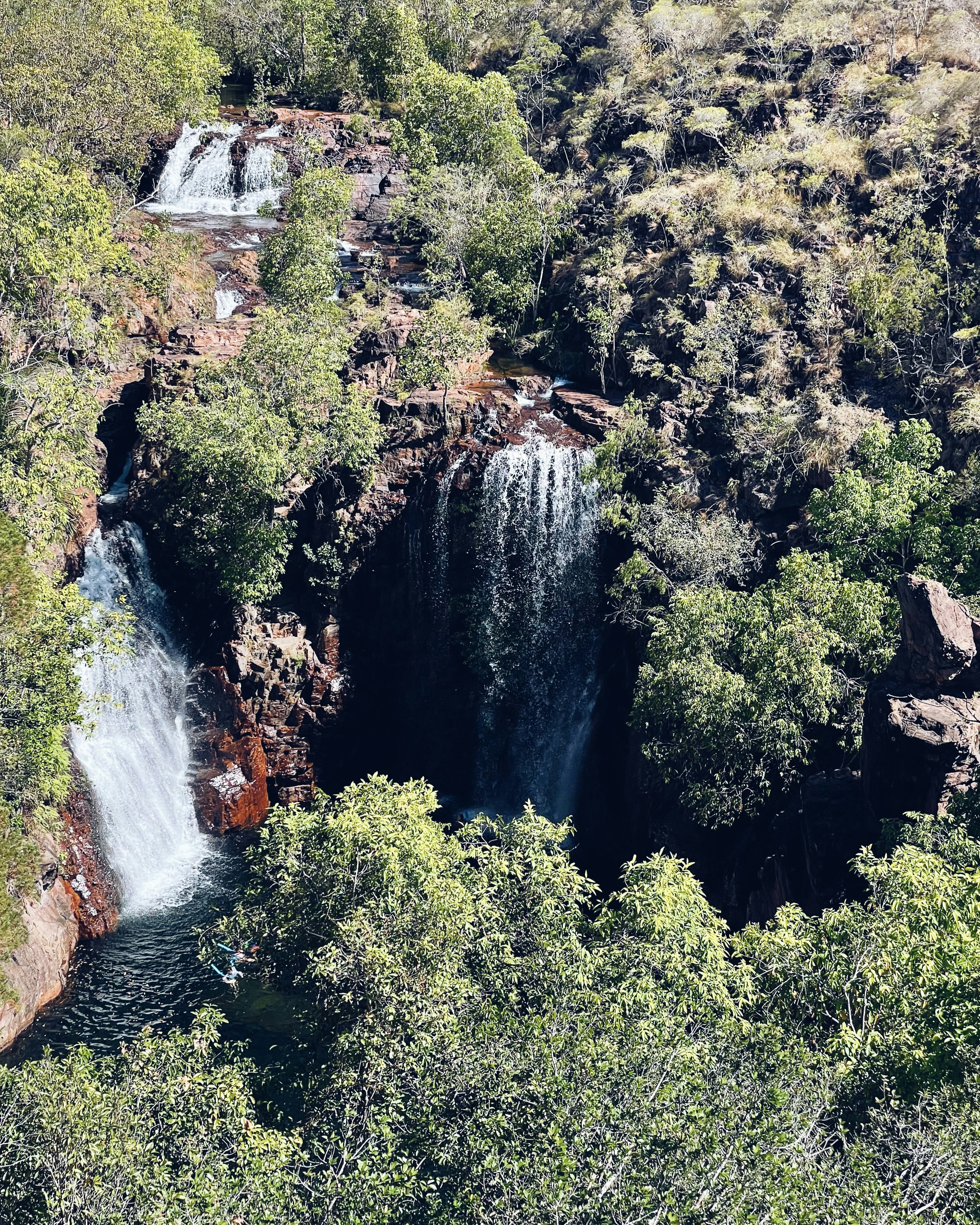Introduction to Litchfield National Park
Litchfield National Park, situated in the Northern Territory of Australia, is a remarkable natural reserve that spans approximately 1,500 square kilometers. Located around 100 kilometers southwest of Darwin, this park is a sanctuary of pristine landscapes and diverse ecosystems, making it a prominent destination for nature enthusiasts and tourists alike. Established in 1986, Litchfield National Park has grown in popularity due to its striking waterfalls, lush rainforests, and intriguing historical sites. The park’s accessibility from Darwin enhances its appeal, attracting numerous visitors each year seeking to explore its natural wonders.
The park is renowned for its rich biodiversity, housing an extensive array of flora and fauna. Visitors can expect to encounter a variety of wildlife, including wallabies, possums, and numerous bird species such as the rainbow bee-eater and the black kite. The lush monsoon forests, open woodlands, and magnetic termite mounds further contribute to the park’s ecological diversity, providing a unique glimpse into Australia’s natural heritage.
One of the most compelling features of Litchfield National Park is its impressive waterfalls. Iconic sites like Florence Falls, Wangi Falls, and Tolmer Falls draw travelers from across the globe, each offering a distinct and breathtaking experience. These waterfalls not only enhance the park’s scenic beauty but also provide refreshing swimming spots and opportunities for adventurous activities like hiking and photography. Additionally, the park’s well-maintained facilities and walking trails cater to visitors of all ages and fitness levels, ensuring an enjoyable and accessible exploration of its natural attractions.
Litchfield National Park’s significance extends beyond its environmental value; it also holds cultural importance for the traditional custodians of the land, the Wagait people. Visitors are encouraged to respect the cultural heritage and practices of the Indigenous communities, enriching their overall experience of this extraordinary natural reserve.
The Waterfalls of Litchfield National Park
Litchfield National Park, located in the Northern Territory of Australia, is renowned for its stunning waterfalls that attract visitors from around the globe. Among the most notable waterfalls in the park are Florence Falls, Wangi Falls, and Tolmer Falls, each offering unique and captivating experiences.
Florence Falls, a dual cascade waterfall, is one of the park’s most popular attractions. It plunges approximately 64 meters into a crystal-clear plunge pool, surrounded by lush monsoon forest. Visitors can enjoy swimming in the pool, which is accessible via a short but steep walk. The best time to visit Florence Falls is during the wet season, from November to April, when the flow is at its peak, creating a dramatic and mesmerizing display.
Wangi Falls is another highlight of Litchfield National Park. This waterfall features a broader, more powerful flow that cascades over a wide rock face into a large swimming hole. Wangi Falls is easily accessible and offers facilities such as picnic areas and a nearby café, making it an ideal spot for families. The falls are best visited during the dry season, from May to October, when the water is clear and safe for swimming. However, the wet season presents a spectacular view of the falls at their fullest, although swimming may be restricted due to strong currents and potential crocodile presence.
Tolmer Falls, though less accessible than Florence and Wangi Falls, offers a breathtaking view from a lookout point. This waterfall features a dramatic drop of roughly 100 meters into a deep plunge pool, flanked by rugged cliffs. Tolmer Falls is renowned for its serene and picturesque setting, making it a favorite among photographers. The falls are best viewed during the wet season when the water flow is most impressive, but the lookout is accessible year-round.
Each of these waterfalls in Litchfield National Park provides a unique experience, showcasing the natural beauty and diverse landscapes of Australia. Visitors are encouraged to plan their trips according to the seasonal variations to fully appreciate the splendor of these remarkable waterfalls.
Flora and Fauna Around the Waterfalls
Litchfield National Park, nestled in Australia’s Northern Territory, is a haven for biodiversity, particularly around its stunning waterfalls. The lush vegetation and diverse wildlife form a complex ecosystem that thrives in the vicinity of these natural water features. The tropical monsoon climate creates an environment where a variety of plant species flourish, contributing to the park’s rich botanical landscape.
The flora around the waterfalls is characterized by an abundance of ferns, orchids, and pandanus trees. These plants not only add to the aesthetic appeal but also play a critical role in maintaining the ecological balance. The pandanus, with its distinctive spiky leaves, is particularly prevalent and provides essential habitat for many of the park’s insects and birds. In addition to these, the monsoon forests surrounding the waterfalls are home to eucalyptus trees, melaleucas, and various types of acacias, creating a dense canopy that supports a myriad of life forms.
The fauna in Litchfield National Park is equally impressive. The waterfalls and their surrounding areas are hotspots for wildlife sightings. Visitors can often spot wallabies grazing in the undergrowth, monitor lizards basking on warm rocks, and a variety of bird species flitting through the trees. Notably, the endemic black flying foxes and rare orange horseshoe bats find refuge in the park, contributing to its unique biodiversity. The waterways themselves are teeming with life, including freshwater fish and the occasional freshwater crocodile, which add to the dynamic nature of these ecosystems.
These ecosystems around Litchfield National Park’s waterfalls are vital for the park’s overall environment. They support a delicate balance of flora and fauna, ensuring the natural harmony of the region. The endemic and rare species found here underline the importance of conservation efforts to protect and preserve this remarkable biodiversity for future generations.
Activities and Attractions
When visiting Litchfield National Park, the multitude of activities and attractions available ensures an enriching experience for all types of travelers. One of the most popular activities is swimming. The park’s numerous waterfalls, including Florence Falls, Buley Rockhole, and Wangi Falls, offer pristine swimming spots where visitors can enjoy the refreshing waters surrounded by stunning natural scenery. Each swimming area is well-maintained, providing safe and accessible locations for families and solo travelers alike.
Hiking enthusiasts will find a variety of trails suitable for different skill levels. The Florence Falls Loop Walk and the Wangi Falls Track are among the most frequented, providing breathtaking views of the waterfalls and the park’s lush landscape. For those seeking a more challenging trek, the Tabletop Track offers a longer and more demanding hike, traversing through diverse terrains and providing an immersive experience in the park’s natural beauty.
Picnicking is another favored activity at Litchfield National Park. Designated picnic areas equipped with tables and seating are located near major attractions, allowing visitors to enjoy a leisurely meal amidst the serene environment. These spots are perfect for families and groups, providing a comfortable setting for relaxation and socialization.
Beyond the self-guided activities, Litchfield National Park offers a range of guided tours and educational programs. Expert guides provide insightful tours that delve into the park’s history, wildlife, and ecological significance. Additionally, educational programs are available, often focusing on the unique flora and fauna of the region, as well as the cultural heritage of the Indigenous people who have historically inhabited the area.
For those interested in more adventurous activities, the park also offers opportunities for bird watching, photography, and even camping. Campgrounds are available for visitors wishing to extend their stay and fully immerse themselves in the natural beauty of Litchfield National Park. Whether you’re looking to cool off in the waterfalls, embark on a scenic hike, or simply enjoy a picnic in a picturesque setting, Litchfield National Park has something to offer every visitor.
Visitor Tips and Safety Information
When planning a visit to Litchfield National Park, being well-prepared can significantly enhance your experience. The park, renowned for its stunning waterfalls and serene natural pools, is best visited during the dry season, which spans from May to October. During this period, the weather is more predictable, trails are more accessible, and most importantly, swimming spots are generally safer.
It’s advisable to bring along essential items such as sunscreen, insect repellent, a hat, and plenty of water to stay hydrated. Comfortable, sturdy footwear is necessary for exploring the various trails. A map of Litchfield National Park is also useful to navigate the different attractions and ensure you don’t miss any of the park’s highlights.
For those looking to swim in the park’s natural pools, such as those at Florence Falls or Wangi Falls, it’s crucial to check for any safety warnings or closures. Swimming is generally safe during the dry season, but it’s essential to heed any posted signs or advice from park rangers regarding water conditions and potential hazards. Crocodile safety is a significant concern; always be vigilant and avoid swimming in areas where crocodiles may be present.
Hiking around the waterfalls offers breathtaking views, but it can also be physically demanding. Ensure you are adequately prepared for the terrain, which can be uneven and slippery, particularly near the falls. Stay on marked trails to protect both yourself and the delicate ecosystems within the park. Bringing a first-aid kit is always a good precaution for any minor injuries that might occur.
In summary, a visit to Litchfield National Park can be a memorable adventure when approached with the right preparation and awareness. Respect the natural environment, follow safety guidelines, and enjoy the unparalleled beauty of Australia’s waterfalls with peace of mind.
Sustainable Tourism and Conservation Efforts
Litchfield National Park, renowned for its breathtaking waterfalls and diverse ecosystems, has become a focal point for sustainable tourism and conservation efforts. The increasing popularity of the park has necessitated robust measures to ensure that its natural beauty and ecological integrity are preserved for future generations. These efforts are driven by a collaborative approach involving government agencies, non-profit organizations, and the local community.
One of the key initiatives in Litchfield National Park is the implementation of strict visitor guidelines designed to minimize environmental impact. Park authorities have established designated trails and viewing platforms to protect fragile habitats from trampling and erosion. Additionally, educational programs are in place to raise awareness among visitors about the importance of staying on marked paths and respecting wildlife. These measures not only safeguard the park’s unique flora and fauna but also enhance the visitor experience by providing structured, yet immersive, ways to explore the park.
Conservation efforts extend beyond visitor management. Active restoration projects are underway to rehabilitate degraded areas within the park. These projects often involve the removal of invasive species, reforestation with native plants, and the maintenance of natural waterways to ensure the health of the park’s ecosystems. Furthermore, partnerships with indigenous communities play a crucial role in conservation, as traditional land management practices and ecological knowledge contribute significantly to the park’s preservation.
Visitors can also play a vital role in conservation by adopting sustainable practices during their visit. Simple actions such as carrying reusable water bottles, reducing waste by packing out all trash, and using eco-friendly sunscreen can collectively make a substantial difference. Moreover, supporting local businesses that adhere to sustainable practices can help foster a community-wide commitment to environmental stewardship.
Litchfield National Park serves as a model for sustainable tourism, demonstrating that with thoughtful planning and community involvement, it is possible to enjoy natural wonders while ensuring their protection. By embracing conservation efforts and practicing responsible tourism, we can help preserve the park’s pristine waterfalls and rich biodiversity for generations to come.
Enter your email to get the Latest Updated Exploring News and Topics
Discover more from atozexplore.com
Subscribe to get the latest posts sent to your email.







